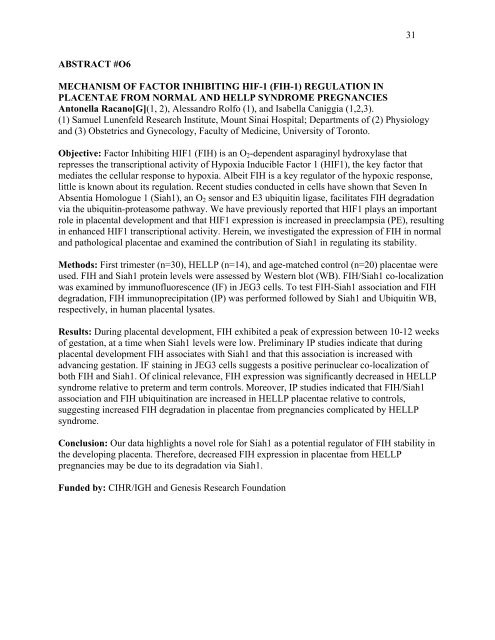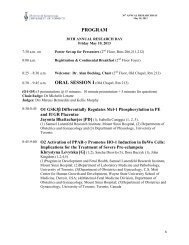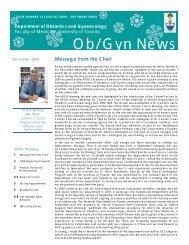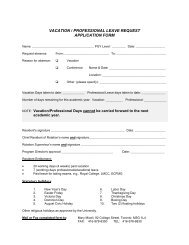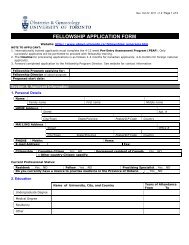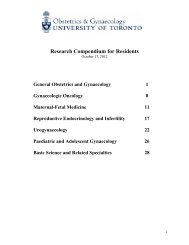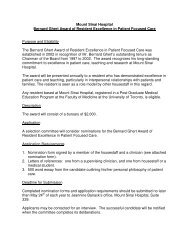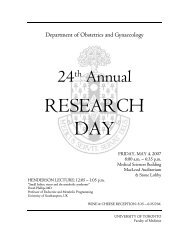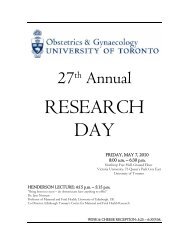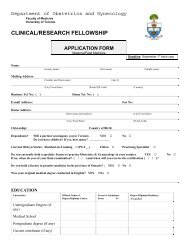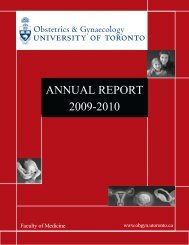research day - University of Toronto Department of Obstetrics and ...
research day - University of Toronto Department of Obstetrics and ...
research day - University of Toronto Department of Obstetrics and ...
Create successful ePaper yourself
Turn your PDF publications into a flip-book with our unique Google optimized e-Paper software.
31<br />
ABSTRACT #O6<br />
MECHANISM OF FACTOR INHIBITING HIF-1 (FIH-1) REGULATION IN<br />
PLACENTAE FROM NORMAL AND HELLP SYNDROME PREGNANCIES<br />
Antonella Racano[G](1, 2), Aless<strong>and</strong>ro Rolfo (1), <strong>and</strong> Isabella Caniggia (1,2,3).<br />
(1) Samuel Lunenfeld Research Institute, Mount Sinai Hospital; <strong>Department</strong>s <strong>of</strong> (2) Physiology<br />
<strong>and</strong> (3) <strong>Obstetrics</strong> <strong>and</strong> Gynecology, Faculty <strong>of</strong> Medicine, <strong>University</strong> <strong>of</strong> <strong>Toronto</strong>.<br />
Objective: Factor Inhibiting HIF1 (FIH) is an O 2 -dependent asparaginyl hydroxylase that<br />
represses the transcriptional activity <strong>of</strong> Hypoxia Inducible Factor 1 (HIF1), the key factor that<br />
mediates the cellular response to hypoxia. Albeit FIH is a key regulator <strong>of</strong> the hypoxic response,<br />
little is known about its regulation. Recent studies conducted in cells have shown that Seven In<br />
Absentia Homologue 1 (Siah1), an O 2 sensor <strong>and</strong> E3 ubiquitin ligase, facilitates FIH degradation<br />
via the ubiquitin-proteasome pathway. We have previously reported that HIF1 plays an important<br />
role in placental development <strong>and</strong> that HIF1 expression is increased in preeclampsia (PE), resulting<br />
in enhanced HIF1 transcriptional activity. Herein, we investigated the expression <strong>of</strong> FIH in normal<br />
<strong>and</strong> pathological placentae <strong>and</strong> examined the contribution <strong>of</strong> Siah1 in regulating its stability.<br />
Methods: First trimester (n=30), HELLP (n=14), <strong>and</strong> age-matched control (n=20) placentae were<br />
used. FIH <strong>and</strong> Siah1 protein levels were assessed by Western blot (WB). FIH/Siah1 co-localization<br />
was examined by immun<strong>of</strong>luorescence (IF) in JEG3 cells. To test FIH-Siah1 association <strong>and</strong> FIH<br />
degradation, FIH immunoprecipitation (IP) was performed followed by Siah1 <strong>and</strong> Ubiquitin WB,<br />
respectively, in human placental lysates.<br />
Results: During placental development, FIH exhibited a peak <strong>of</strong> expression between 10-12 weeks<br />
<strong>of</strong> gestation, at a time when Siah1 levels were low. Preliminary IP studies indicate that during<br />
placental development FIH associates with Siah1 <strong>and</strong> that this association is increased with<br />
advancing gestation. IF staining in JEG3 cells suggests a positive perinuclear co-localization <strong>of</strong><br />
both FIH <strong>and</strong> Siah1. Of clinical relevance, FIH expression was significantly decreased in HELLP<br />
syndrome relative to preterm <strong>and</strong> term controls. Moreover, IP studies indicated that FIH/Siah1<br />
association <strong>and</strong> FIH ubiquitination are increased in HELLP placentae relative to controls,<br />
suggesting increased FIH degradation in placentae from pregnancies complicated by HELLP<br />
syndrome.<br />
Conclusion: Our data highlights a novel role for Siah1 as a potential regulator <strong>of</strong> FIH stability in<br />
the developing placenta. Therefore, decreased FIH expression in placentae from HELLP<br />
pregnancies may be due to its degradation via Siah1.<br />
Funded by: CIHR/IGH <strong>and</strong> Genesis Research Foundation


